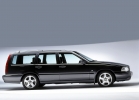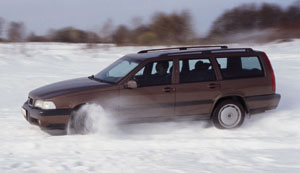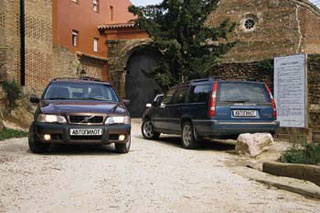Test drive Volvo V70 1997 - 2000 station wagon
WHAT'S IN A NAME
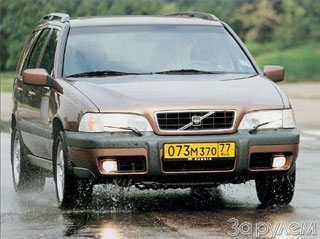 The all -wheel drive Volvo V70 XC AWD with the body wagon debuted in the fall of 1997. The car is equipped with gasoline five -cylinder engines: 2.5 -liter with low -pressure turbocharged - 193 liters. With. or 2 -liter high -pressure turbocharged - 225 liters. With. The gearbox is a mechanical five -speed or automatic four -speed.
The all -wheel drive Volvo V70 XC AWD with the body wagon debuted in the fall of 1997. The car is equipped with gasoline five -cylinder engines: 2.5 -liter with low -pressure turbocharged - 193 liters. With. or 2 -liter high -pressure turbocharged - 225 liters. With. The gearbox is a mechanical five -speed or automatic four -speed. The Volvo V70 XC AWD is the only car in the company's lineup, awarded the name of its own: the inscription Cross Country is flaunting on the fifth door. There is no need to delve into the subtleties of the translation, the main thing - in the V70 family, an all -wheel drive station wagon of increased cross -country ability appeared. The representative of the fashionable and, importantly, of the practical class of machines. Not a jeep yet, but no longer asphalt tender. A spacious, comfortable and prestigious passenger car, better than others adapted to driving on bad roads.
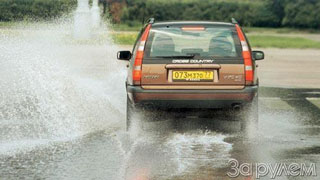 What is the difference between a cross-country from an ordinary all-wheel drive station wagon V70 AWD (ZR, 1997, No. 2)? External changes in cosmetic - a new grille of the radiator, a massive front bumper, the fifth door, original wheels of light alloy wheels. Plastic lateral moldings, thresholds, lower parts of the front and rear bumper by car are not painted in the color of the body, because when moving along the lane, these details suffer more than others, so covering them with expensive metallic is not too practical. In addition, the gray elements released from the general color scheme give the car a courageous off -road appearance.
What is the difference between a cross-country from an ordinary all-wheel drive station wagon V70 AWD (ZR, 1997, No. 2)? External changes in cosmetic - a new grille of the radiator, a massive front bumper, the fifth door, original wheels of light alloy wheels. Plastic lateral moldings, thresholds, lower parts of the front and rear bumper by car are not painted in the color of the body, because when moving along the lane, these details suffer more than others, so covering them with expensive metallic is not too practical. In addition, the gray elements released from the general color scheme give the car a courageous off -road appearance. Cross-Kantry did not save on the comfort of the driver and passengers. The full drive of an increased cross-country ability is the same as that of richly equipped cars of the 70th series. Even, maybe even more luxurious. There is a skin and wood, a mass of servo drives, air conditioning, an on-board computer, alarm, a musical center with a compact dosks player and nine (!) Speakers. And the innovations are somehow connected with the trunk. In the backs of the rear seats are hidden sliding grids, which can be separated by the cabin from the cargo compartment. In the trunk itself there are two cells for small objects and a rug rolled into a tube. They are covered by the rear bumper sprayed with mud so as not to stain clothes during loading and unloading. The list of additional equipment for the trunk is impressive: from the upper shelf and cells in which dogs are transported to a number of children's seat belts deployed against the movement of a number of children's seat belts.
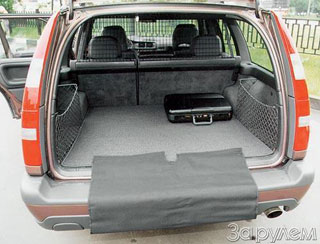 In addition to all -wheel drive, the modification of the chassis helped to increase patency. So, for example, the rear suspension automatically supports the road clearance. In addition, the wheels of increased diameter with tires 205/55R16 or 205/65R15 are installed. However, despite the change in the size of the tires, the tread pattern remained road. What emphasizes once again - Cross -Cantry is still a car, and not an all -terrain vehicle. Thanks to the listed innovations, the clearance of the car grew to 166 mm, which is 26 mm more than that of the other Volvo-V70. There was also protection of the engine and gearbox crankcase. Moreover, not a whole sheet of metal, but a cage from thick durable rods. It is able to withstand strong blows, but at the same time does not prevent the air from cooling the power unit.
In addition to all -wheel drive, the modification of the chassis helped to increase patency. So, for example, the rear suspension automatically supports the road clearance. In addition, the wheels of increased diameter with tires 205/55R16 or 205/65R15 are installed. However, despite the change in the size of the tires, the tread pattern remained road. What emphasizes once again - Cross -Cantry is still a car, and not an all -terrain vehicle. Thanks to the listed innovations, the clearance of the car grew to 166 mm, which is 26 mm more than that of the other Volvo-V70. There was also protection of the engine and gearbox crankcase. Moreover, not a whole sheet of metal, but a cage from thick durable rods. It is able to withstand strong blows, but at the same time does not prevent the air from cooling the power unit. Now let's talk about running qualities. If outwardly the V70 XC AWD looks like a cargo-passenger liner with something, then in motion it can be compared with a conventional low-profile. Contrary to the expectations of a large station wagon fits perfectly into the city stream. It is very easy to manage it. The only reminder of increased patency is a more stringent suspension than others. However, you do not feel discomfort from her work. You get used to the size of the car pretty quickly, besides, the visibility from the driver's place is simply excellent. Automatic gearbox, sensitive steering. What else is needed? If necessary, you can confidently smash in a dense flow of cars.
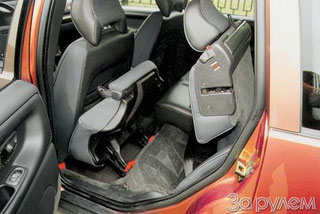 On suburban tracks, the car is able to drive quickly. Moreover, you practically do not feel high speed, and only looking at the speedometer, you see that it has long exceeded the restrictions established by the rules. If you need to overtake someone, a traction engine with a low -pressure turbocharger allows you to accelerate almost instantly.
On suburban tracks, the car is able to drive quickly. Moreover, you practically do not feel high speed, and only looking at the speedometer, you see that it has long exceeded the restrictions established by the rules. If you need to overtake someone, a traction engine with a low -pressure turbocharger allows you to accelerate almost instantly. But much more Cross-Kantry has a imposing, measured ride. And there are reasons for that. Firstly, calm, without the slightest hint of sports, the character characteristic of family cars. If the V70 XC does not spur, then it seems to swim softly, and not rolling along the road. Secondly, high fuel consumption. It is worth sharply pressing the gas pedal, as the on-board computer will tell you how much expensive high-octane gasoline AI-95 or 98 flew into the exhaust pipe. To spend no more than 11 l/100 km, you have to get used to the economical driving style.
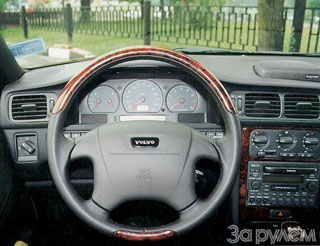 The off-road qualities of Volvo Cross-Cantry are quite high. In any case, it is adapted to our countryside much better than most cars. When going to force the next obstacle, it remains only not to forget about the free -plated road tires and impressive overhangs that limit the geometric cross -country ability of the station wagon. That is, do not set juper tasks in front of the machine. A powerful engine and smart all -wheel drive transmission will take care of the rest. Under ordinary conditions, only the front wheels work on dry asphalt leaders. But if they start to slip, as Wyskoft transmits the torque and to the rear. If the speed does not exceed 40 km/h, the electronic traction control system (Tracs) also works. She distributes the moment between the front wheels. The larger is supplied to the one that has better adhesion to the road surface. In addition, the rear axle is equipped with a differential of high friction. In addition to overcoming lanes, such a transmission will help the driver in winter when snow or ice is under the wheels.
The off-road qualities of Volvo Cross-Cantry are quite high. In any case, it is adapted to our countryside much better than most cars. When going to force the next obstacle, it remains only not to forget about the free -plated road tires and impressive overhangs that limit the geometric cross -country ability of the station wagon. That is, do not set juper tasks in front of the machine. A powerful engine and smart all -wheel drive transmission will take care of the rest. Under ordinary conditions, only the front wheels work on dry asphalt leaders. But if they start to slip, as Wyskoft transmits the torque and to the rear. If the speed does not exceed 40 km/h, the electronic traction control system (Tracs) also works. She distributes the moment between the front wheels. The larger is supplied to the one that has better adhesion to the road surface. In addition, the rear axle is equipped with a differential of high friction. In addition to overcoming lanes, such a transmission will help the driver in winter when snow or ice is under the wheels. + Good sledge qualities and cross -country ability, rich equipment, spacious interior, capacious trunk.
- High price, a spare wheel-peroka, a high fuel consumption.
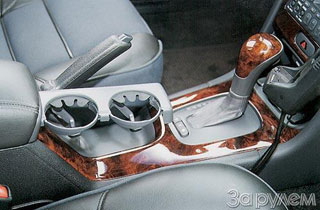 TECHNICAL SPECIFICATIONS
TECHNICAL SPECIFICATIONS General data: number of places - 5; Equipped mass - 1688 kg; full weight - 2160 kg; maximum speed - 205 km/h; acceleration time from a place to 100 km/h - 9.1 s; The average conditional fuel consumption is 11.8 l/100 km; fuel supply - 70 liters; Fuel is unhealthy gasoline AI -95. Dimensions, mm: length - 4722; width - 1761; height - 1502; base - 2654; The track in front/back - 1520/1490; Road clearance - 166; The volume of the trunk is 480/1610 l. Engine: five -cylinder in line, four valves per cylinder, distributed fuel injection, low -pressure turbocharged; located in front transversely; working volume - 2435 cm; cylinder diameter and piston stroke - 83x90 mm; compression degree - 9.0; Power - 142 kW/193 l. With. at 5100 rpm; The maximum torque is 270 N.M at 1800-5000 rpm. Transmission: all -wheel drive; gearbox - four -speed automatic; Transporting numbers: I - 3.61; II - 2.06; III - 1.37; IV - 0.98; h. X. - 3.95; The main program is 2.56. Suspension: in front - independent, such as McEferson with a reptile stability stabilizer, from behind - a multi -link spring with a system of automatic maintenance of road clearance. Brakes: hydraulic disk with a vacuum amplifier and ABS, in front - ventilated. Tire size: 205/55R16 or 205/65R15.
SUMMARY
Volvo V70 XC AWD is a solid station wagon that does not require adaptation to Russian conditions. Respectable and at the same time practical, with good cross -country ability, but not to the expense of comfort. According to most indicators, it is quite suitable for the role of a single car in the family - for daily trips around the city, warriors to the country, travel, transportation of goods, and towing trailers. Good for everyone, but dear: about $ 50,000.
Vadim Kryuchkov. Photo by Alexander Polunin
Source: The magazine "Driving"


